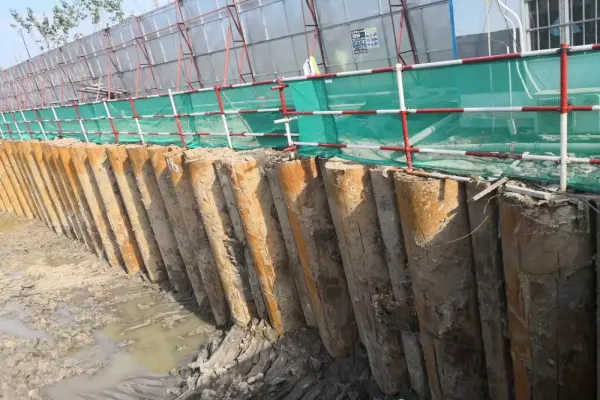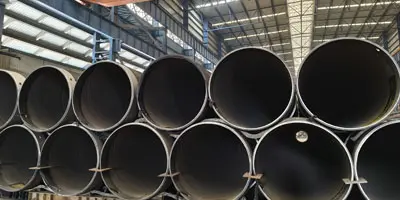In construction and civil engineering, steel pipe piles are essential materials used in a variety of applications, including foundation pit support, brackets, pier foundations, and drilling platforms. Steel pipe piles are available in a range of specifications, with typical diameters ranging from 220mm to 1200mm and wall thicknesses from 8mm to 20mm. These varying specifications correspond to different application scenarios and load-bearing requirements. An important consideration in the use of steel pipe piles is their weight, which is closely related to their specifications. But how exactly does the weight of steel pipe piles correlate with their specifications? This article aims to explore this correlation and provide a clearer understanding of how these factors influence one another.
Before diving into the calculation, let’s first understand what a steel pipe pile is. A steel pipe pile is a cylindrical hollow structure made from high-strength steel, designed to be driven into the ground to provide foundational support for heavy structures. These piles are hollow, meaning they have an outer diameter (D) and a wall thickness (t). The weight calculation will take into account the material's density and the geometry of the pipe.Generally, welded steel pipes can be used as steel pipe piles.
Calculation Methods for Steel Pipe Pile Weight
The weight of steel pipe piles can be calculated using two primary methods: the weight method and the volume method. Both methods consider the key parameters such as the length, diameter, thickness, and density of the steel pipe pile.
Weight Calculation Method
The weight calculation method is based on the principle of mass distribution and overall strength. The formula to calculate the weight of a steel pipe pile is:
Weight (kg)=Pile Length (m)×Cross-Sectional Area (m²)×Steel Density (kg/m³)
Typically, the density of steel is 7850 kg/m³, though this may vary slightly depending on the type and composition of the steel. This method is commonly used in situations where precise calculations of bearing capacity are needed, as it provides an accurate reflection of the pile's mass distribution and overall strength.
Volume Calculation Method
The volume method is simpler and more commonly used in logistics, transportation, or construction measurements. The formula for calculating the volume is:
Volume (m³)=Pile Length (m)×Cross-Sectional Area (m²)
While this method is easier to use for estimating purposes, it doesn't directly reflect the weight or mass distribution of the steel pipe piles. As such, in applications requiring precise weight calculations, the weight calculation method remains the preferred choice.
How Specifications Affect the Weight of Steel Pipe Piles
The specifications of a steel pipe pile, particularly its diameter, wall thickness, and length, play a crucial role in determining its weight. Let's examine the impact of each specification:
Diameter (D): The larger the diameter, the larger the cross-sectional area of the pipe, which increases its overall weight. A larger diameter results in more material being used, which directly increases the mass.
Wall Thickness (t): The wall thickness significantly impacts the weight of the pile. The thicker the wall, the greater the volume of material, thus increasing the weight of the steel pipe pile.
Length (L): Longer steel pipe piles also weigh more due to the larger amount of steel involved. As the length increases, the overall mass of the pile increases proportionally.
These factors collectively determine the overall weight of a steel pipe pile. To make this clearer, let’s walk through an example.
How to Calculate the Weight of a Steel Pipe Pile
Let’s consider two steel pipe piles with different specifications:
1.Steel Pipe Pile 1:
Diameter = 200mm
Length = 3m
Wall Thickness = 8mm
2.Steel Pipe Pile 2:
Diameter = 300mm
Length = 4m
Wall Thickness = 12mm
Using the weight calculation formula, we can determine the weight of each pile.
For Steel Pipe Pile 1:
The weight can be calculated as follows:
Weight=0.024×200×200×3×8/1000=114.58kg
For Steel Pipe Pile 2:
The weight will be greater due to the larger diameter, length, and wall thickness:
Weight=0.024×300×300×4×12/1000=326.59kg
As we can see, the second pile, with larger dimensions, has a significantly higher weight.
Indirect Factors Influencing the Weight of Steel Pipe Piles
Apart from the direct specifications, other factors can indirectly affect the weight of steel pipe piles:
Material Type and Density: Different types of steel have varying densities. For example, high-strength steel or alloy steel may have a higher density, which results in a greater weight for the same size steel pipe pile.
Surface Treatment: Steel pipe piles are often treated with protective coatings such as hot-dip galvanizing or painting. While these coatings enhance the corrosion resistance and service life of the piles, they also add to the overall weight. The additional coating layers, although typically thin, contribute to the pile’s mass.
Precautions in the practical application of steel pipe piles
1. Carrying capacity matching: When selecting specifications, it is necessary to combine the engineering load requirements to avoid structural risks due to insufficient weight.
2. Material selection: It is recommended to use galvanized steel pipe piles (such as
GI pipes) in highly corrosive environments, and low-carbon steel (such as MS pipes) can be used in ordinary environments.
3. Transportation and construction: Extra-long or extra-heavy steel pipe piles require planning for lifting and transportation plans.
4.In addition to the specification factors that directly affect the weight of steel pipe piles, there are also some indirect factors. For example, different steel materials and densities will result in different weights of steel pipe piles of the same specifications. Some special steels, such as high-strength steel or alloy steel, may have a higher density, which increases the weight of steel pipe piles. In addition, the surface treatment of steel pipe piles, such as hot-dip galvanizing and painting, will also increase their weight. Although these additional treatment layers can enhance the corrosion resistance and service life of steel pipe piles, they will also increase their overall weight to a certain extent.

Conclusion
There is a strong correlation between the specifications and weight of steel pipe piles. Steel pipe piles with larger diameters, thicker walls, and longer lengths have higher weights and are capable of bearing greater loads. When selecting and using steel pipe piles, it is important to consider the engineering needs and geological conditions to ensure that the piles meet the safety and stability requirements of the project.
Understanding how the specifications affect the weight of steel pipe piles is essential for making informed decisions in construction and civil engineering projects. By considering both direct and indirect factors, engineers can ensure that they select the appropriate steel pipe piles for their specific applications, optimizing both performance and cost-effectiveness.






 English
English Español
Español بالعربية
بالعربية











 Phone :
Phone :  Whatsapp :
Whatsapp :  Email :
Email : 


